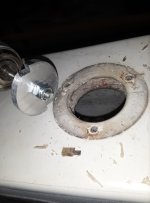Hello all,
22 Cruiser preventative maintenance. I'm beginning the process of removing a number of items screwed into the hull and epoxy potting screws to avert dreaded water intrusion. I'm starting with brackets holding up the rear seat (containing the water tank) and under the sink/stove counter and holding the foot pump in place - the current brackets (galvanized?) are quite corroded, and I'll replace with stainless steel hardware. All goes well, I'll progress over time to other fasteners in the hull (e.g. screws in the retaining strip in front of the fuel tanks).
Putting Dremel to hull, though, is a daunting prospect. My question to others who have done this before: how do I gauge the depth of the balsa, and avoid chewing into (or through!) the fibreglass of the outer hull surface?
Thanks!
Oliver
22 Cruiser preventative maintenance. I'm beginning the process of removing a number of items screwed into the hull and epoxy potting screws to avert dreaded water intrusion. I'm starting with brackets holding up the rear seat (containing the water tank) and under the sink/stove counter and holding the foot pump in place - the current brackets (galvanized?) are quite corroded, and I'll replace with stainless steel hardware. All goes well, I'll progress over time to other fasteners in the hull (e.g. screws in the retaining strip in front of the fuel tanks).
Putting Dremel to hull, though, is a daunting prospect. My question to others who have done this before: how do I gauge the depth of the balsa, and avoid chewing into (or through!) the fibreglass of the outer hull surface?
Thanks!
Oliver

